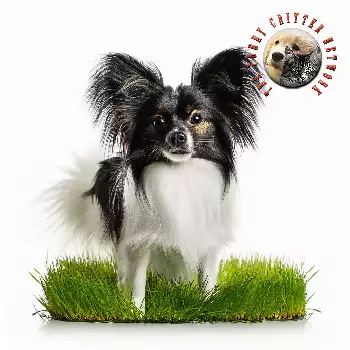Papillons are generally healthy dogs with an impressive lifespan of 14 to 16 years, and many individuals live even longer with proper care. This longevity is one of the breed's advantages, allowing owners to enjoy many years with their companions. Maintaining good health requires regular veterinary care, proper nutrition, adequate exercise, and attention to genetic health concerns that can affect the breed.
Patellar luxation represents one of the most common orthopedic issues in Papillons and other toy breeds. This condition occurs when the kneecap slips out of its normal position, causing lameness or an abnormal gait. Patellar luxation ranges from mild cases that cause occasional skipping to severe cases requiring surgical correction. Reputable breeders screen their breeding stock for this condition through orthopedic examinations to reduce its incidence. Maintaining a healthy weight helps reduce stress on the joints and may decrease the severity of symptoms.
Progressive retinal atrophy (PRA) is an inherited eye disease that can affect Papillons, leading to gradual vision loss and eventual blindness. This condition typically appears in middle-aged to older dogs, though onset age can vary. Genetic testing is available to identify carriers and affected dogs, allowing responsible breeders to make informed breeding decisions. While there is no cure for PRA, affected dogs typically adapt well to vision loss and can maintain good quality of life with appropriate environmental modifications and owner support.
Dental disease affects many toy breeds, including Papillons, due to their small jaw size and crowded teeth. Without proper dental care, plaque and tartar accumulation can lead to periodontal disease, tooth loss, and potentially serious infections that affect overall health. Regular veterinary care includes dental examinations and professional cleanings when necessary to maintain oral health. Daily tooth brushing at home significantly reduces dental problems and is one of the most important preventive care measures owners can take.
Heart conditions, particularly mitral valve disease, can affect older Papillons. This progressive condition involves degeneration of the heart's mitral valve, leading to decreased cardiac efficiency. Regular veterinary examinations including heart auscultation help detect heart murmurs or other signs of cardiac disease early. While heart disease cannot always be prevented, early detection allows for management strategies that can improve quality of life and longevity. Maintaining a healthy weight and providing appropriate exercise supports cardiovascular health throughout the dog's life.
Regular veterinary examinations are essential for maintaining your Papillon's health throughout their life. Puppies require a series of vaccinations and deworming treatments to protect against infectious diseases and parasites. Adult dogs should receive annual wellness examinations, though senior dogs (typically over age 7 or 8) may benefit from more frequent check-ups. Preventive care through regular vet visits allows early detection of health issues before they become serious problems.
Vaccinations protect Papillons from serious infectious diseases including rabies, distemper, parvovirus, and other potentially fatal illnesses. Your veterinarian will recommend an appropriate vaccination schedule based on your dog's age, health status, and lifestyle. Core vaccines are essential for all dogs, while non-core vaccines may be recommended based on geographic location and exposure risk. Keeping vaccination records current ensures your dog remains protected throughout their life.
Parasite prevention is crucial for maintaining health. Year-round heartworm prevention protects against this potentially fatal parasitic infection transmitted by mosquitoes. Flea and tick prevention products help prevent infestations and the diseases these parasites can transmit. Internal parasite prevention and regular fecal examinations help detect and treat intestinal parasites. Your veterinarian can recommend appropriate parasite prevention products based on your location and your dog's lifestyle.
Maintaining a healthy weight throughout your Papillon's life helps prevent numerous health problems including joint issues, heart disease, and diabetes. These small dogs don't require large amounts of food, and it's easy to overfeed them with treats and table scraps. Feeding a high-quality dog food appropriate for their life stage (puppy, adult, or senior) in measured amounts helps maintain ideal body condition. Your veterinarian can assess your dog's body condition and recommend appropriate feeding amounts.
Common Health Issues
- Patellar luxation represents one of the most common orthopedic issues in Papillons and other toy breeds.
- Patellar luxation ranges from mild cases that cause occasional skipping to severe cases requiring surgical correction.
- Dental disease affects many toy breeds, including Papillons, due to their small jaw size and crowded teeth.
- While heart disease cannot always be prevented, early detection allows for management strategies that can improve quality of life and longevity.
- Maintaining a healthy weight throughout your Papillon's life helps prevent numerous health problems including joint issues, heart disease, and diabetes.
Preventive Care & Health Monitoring
- Maintaining good health requires regular veterinary care, proper nutrition, adequate exercise, and attention to genetic health concerns that can affect the breed.
- Without proper dental care, plaque and tartar accumulation can lead to periodontal disease, tooth loss, and potentially serious infections that affect overall health.
- Regular veterinary care includes dental examinations and professional cleanings when necessary to maintain oral health.
- Daily tooth brushing at home significantly reduces dental problems and is one of the most important preventive care measures owners can take.
Regular veterinary check-ups and preventive care are essential for maintaining your Butterfly Dog's health and longevity.

